As an Amazon Associate I earn from qualifying purchases.
I love curries in all their forms, which means that venison curry is on the menu all season.
This is a Thai-style massaman curry, which normally uses beef, and you can do the same if you are not a hunter. But I do prefer this with venison.
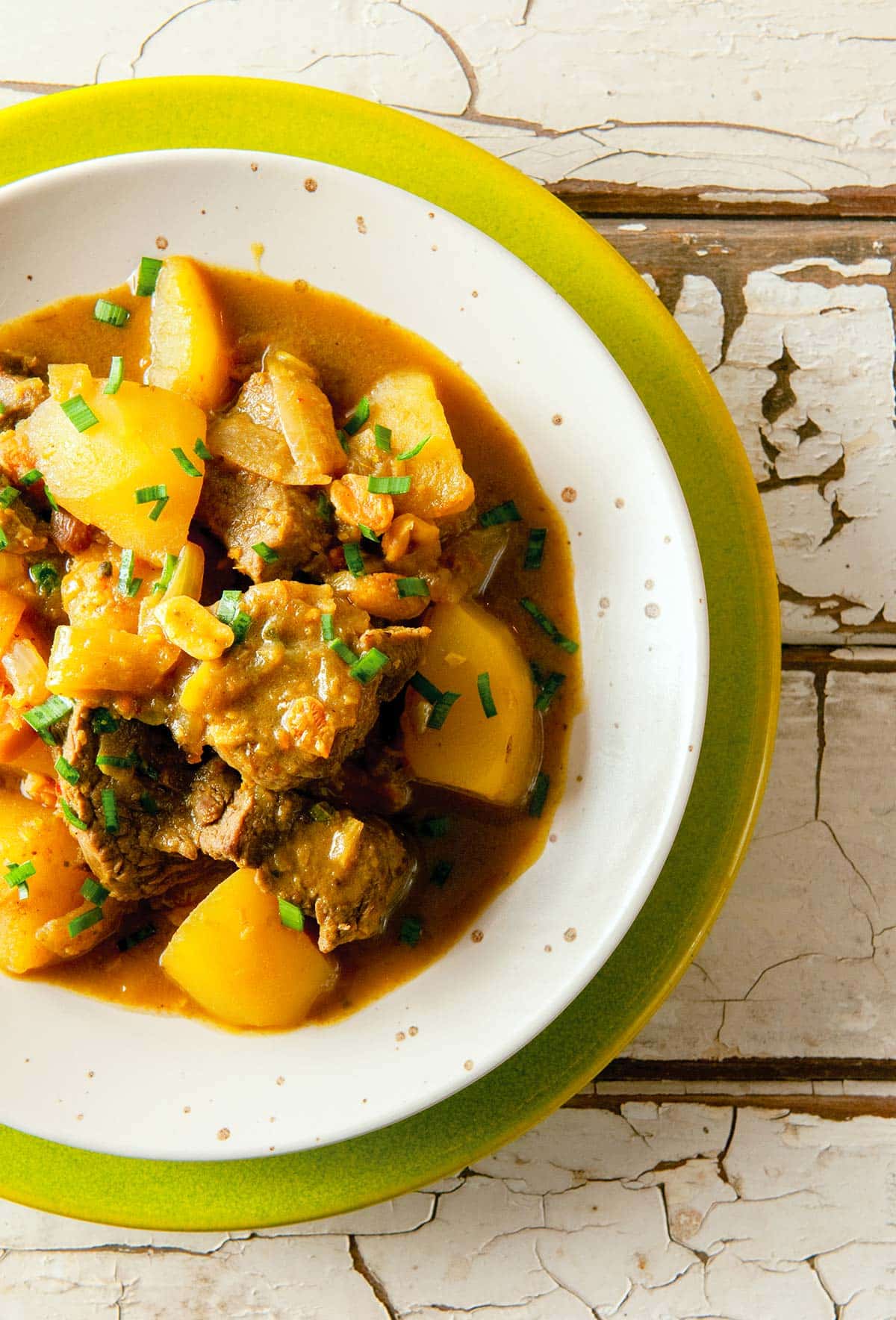
For most of my cooking life, curries have been something I’ve enjoyed in restaurants, not at home. Part of the reason is all those exotic ingredients. Part of it is the notion that a truly great curry surely must come from fresh ingredients, just like truly great Western food does.
Turns out most curries aren’t in fact made with fresh ingredients. Most are made from Byzantine spice mixes, cooked in unusual oils and simmered with vegetables I am not too familiar with. And, more specifically to my purchase, there are lots of curries that don’t use turmeric at all.
As it happens, this Thai-style massaman curry is one of them. So my addition of fresh turmeric is, while not crazy — I’ve seen it used in some recipes — apparently not traditional. Oh well. Why this curry then? Well, it goes especially well with venison.
Massaman curry is a Thai version of the curries further west, in Muslim Pakistan and the like. Massaman is, scholars believe, a corruption of “Muslim.” It is a yellow curry, often with potatoes and is not typically incendiary like most Thai curries. And unlike green curries, which are awesome with fish, this yellow curry is tailor-made for beef, lamb… or venison.
Trolling for recipes, I ended up adapting a classic: The massaman curry recipe in what may be the first Thai cookbook in English, Jennifer Brennan’s Original Thai Cookbook. Since Brennan first wrote that book in 1981, the ingredients required to make a good Thai curry have become easy to find: galangal and turmeric (both relatives of ginger), lemongrass, coconut milk, fish sauce, and premade curry pastes.
I’ve used these premade pastes before; they’re pretty good, actually. Everything in them must be antibacterial or otherwise antiseptic, because they last in the fridge for more than a year. But making curry from scratch make me feel more like a real cook.
(Looking for a different venison curry? Try my Thai green curry venison.)
I have to admit I was a little nervous making this. I can whip up all sorts of Western food without a recipe. I understand these cuisines deep in my bones. Asia is not so second nature for me. So I hewed pretty close to Brannan’s recipe, adding a bit more chile and the turmeric, a few more potatoes. And of course, I used venison, too.
Ever worked with fresh turmeric? Um, I have some advice for you: Wear rubber gloves, and have hot, soapy water at the ready. Most of us know that powdered turmeric stains like a sonofabitch, but fresh is just as bad. It will even stain the allegedly stainless steel, albeit temporarily. My mortar and pestle is yellow now. I am hoping that too will be temporary. (it was)
Because this venison curry does not stew for hours and hours, you need to treat the venison or other meat in a special way.
First, make sure the meat is completely free of all silverskin or connective tissue. Second, drop it into the curry maybe 5 minutes before you serve — just enough time for the chunks of meat to cook through, yet still be pink inside.
I am happy to report this recipe tastes like restaurant curry. And while I loved the massaman curry paste I made, I must admit that the store-bought, premade ones I’ve bought in the past were just as good. Maybe when I get more skilled at this I can surpass them, but not yet.
Meanwhile, you’re going to love this venison curry. Exotic without being overly spicy, yet it is still, at its core, a meat-and-potatoes meal. Give it a go.
Thai Massaman Curry with Venison
Ingredients
CURRY PASTE
- 7-10 dried hot chiles
- 2- inch stick of cinnamon
- 12 cardamom seeds, or 1/2 teaspoon ground
- 1/2 teaspoon ground nutmeg
- 4 bay leaves, crushed fine
- 1 teaspoon salt
- 8 garlic cloves, minced
- 1/2 cup onion, minced
- 1 tablespoon lard or vegetable oil
- 1 tablespoon minced galangal, fresh or pickled
- 2- inch piece of fresh turmeric or 2 teaspoons powdered
- 1 lemongrass stalk, minced
CURRY
- 1 tablespoon lard or vegetable oil
- 1 large onion, sliced
- 1 pound potatoes, peeled and cut into 2-inch chunks
- 1 14- ounce can coconut milk
- 3 tablespoon fish sauce or 2 tablespoons soy sauce
- A 2-inch piece of cinnamon
- 4 tablespoons yellow curry paste (if not using the curry paste above)
- 2 pounds venison, trimmed of fat and silverskin and cut into 1-inch cubes
- Chives or cilantro for garnish
Instructions
- If you are making your own curry paste, heat the tablespoon of lard and sauté the onion and garlic until soft and translucent. Let cool a bit and put into a bowl. While the onions are cooking, grind the chiles, cloves, cinnamon, cardamom, nutmeg, bay leaves and salt into a powder. Put the spice mix into the bowl with the onions and garlic. Add the galangal, turmeric and lemongrass and mix everything well. Pound everything into a rough paste and set aside.
- In a large sauté pan or wok, heat the other tablespoon of lard or vegetable oil and sear the onions over high heat. Toss well to combine, then don't move the onions for a minute or two -- you want some char on them. Toss again and let sear one more time.
- Add the potatoes, coconut milk, fish sauce, cinnamon and enough water to just barely cover the potatoes. Mix in the curry paste one tablespoon at a time and stop when it is spicy enough for you. Cover and simmer until the potatoes are tender, about 30 minutes. When the potatoes are tender, mix in the venison and cook gently for 5 more minutes.
- Serve at once with chives or cilantro, rice and a cold beer.
Notes
Nutrition
Nutrition information is automatically calculated, so should only be used as an approximation.
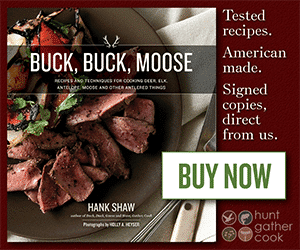


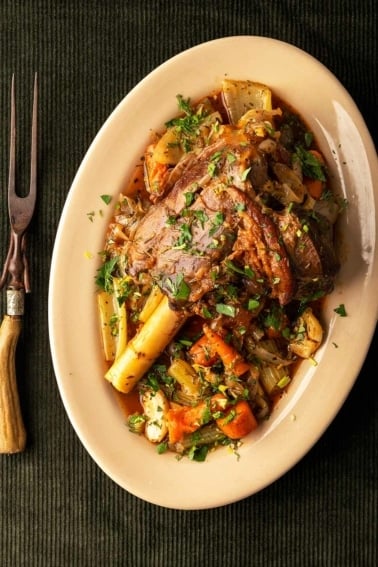
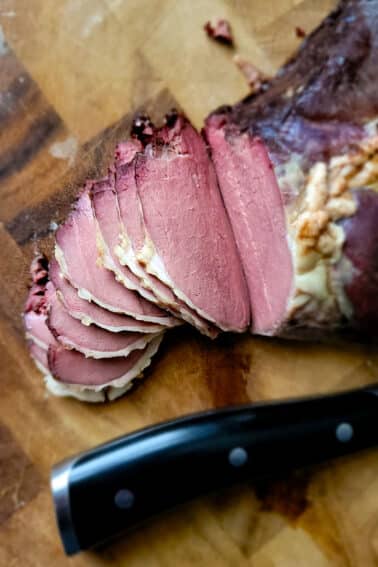
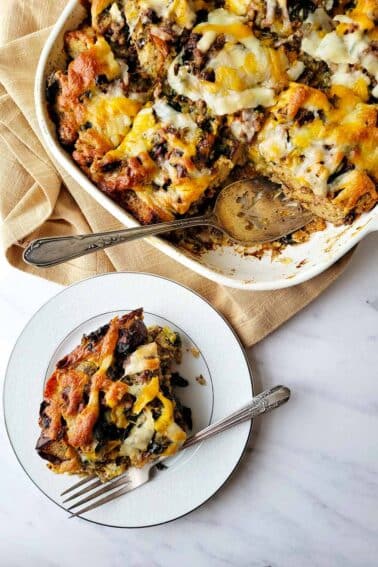
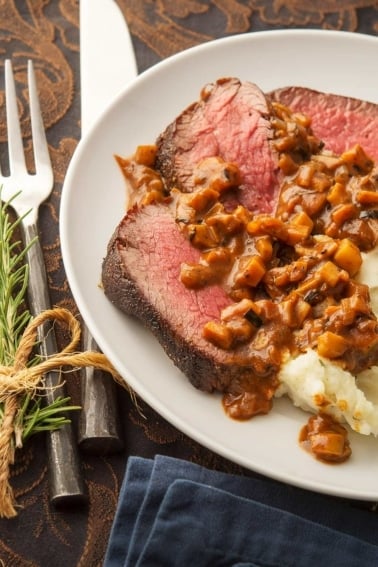
Quick and simple (I used bought yellow curry paste as base) with white tail loin. Lots of flavour, especially for how quick the dish comes together and how short time the meat cooks. Great for a weeknight meal.
Amazing recipe! I subbed on-hand ingredients—chili powder for the chiles, some ginger for the galangal and lemon juice for the lemongrass, and the curry paste was still delicious. Highly recommended!
Curry was wonderful! I used some venison roast cuts for it and the key is trimming off the silverskin for this method of cooking the meat. I was a little wary about it at first but trusted the explanation given above and it worked very well. I topped this with some garlic hot sauce for a little kick and some goat cheese. A wonderful treat for these -30 days in Wisconsin 🙂
Can this curry be reheated?
Brian: Yes. Do it gently though, or it can break emulsion.
Bobbi Jo: Any boneless, lean cut will work. I’d use cubes from the hindquarter. You’ll need to decide if you want the meat pink inside, in which case you don’t cook it very long, or if you want it to be fall-apart tender, in which case you cook the hell out of it at VERY gentle heat, i.e., barely simmering.
Good recipe. Curry paste proportions were tasty!
Against my better judgment I went with the quick cook. I used meat from the hindquarter of a medium doe. Meat was tough.
I am simmering the leftover for a couple hours. I’m sure that will be better.
Thank you for this recipe. It is awesome, and a great use of a fine animal. I tweaked it in the following ways and really enjoyed the results:
1. Omit the onion and oil from the paste
2. Use fresh birdseye chillies
3. Chargrill the garlic and chillies on a skewer over a naked gas flame before mincing and pounding rather than softening in oil
4. Use venison haunch
5. Slow cook in the oven for 1.5 hours at 180C/160 fan with the lid on
6. Add the potatoes for the last 30 mins of cooking
7. Add a handful of peanuts for the last 30 mins of cooking
8. Garnish with crisp slow fried shallots, crushed peanuts and coriander
Simply amazing!
I would like to use elk meat for this recipe…what cut would work best? Saving the back strap for something special..maybe round steak? If so, how does this affect cooking time as I have heard you can overlook elk very easily….
Thanks, Bobbi Jo
Okay, now I am droooooooling. I love curries and this one looks amazing! Caveman Hubby just harvested an elk last week so we are going to have to try this recipe. nom nom.
I live in Sacramento and I want to grow turmeric too. Where do I get the tubers or seeds?
Hank, I love your blog. Not really big on curry, but the aside about foodblogsearch.com is much appreciated. Never heard of it before, but it really looks like a great resource. Thanks, again.
@somsai – I use a banana leaf. Keeps the jungle ladies wonderin’.
Hank take this with a pinch of salt, I’m much more familiar with Lao food but….
Gaeng pa is a common Thai curry, I think what makes it unique is gasai (Lao) gachai or kachai (Thai) a small tuber that has a fairly strong taste. The taste can carry through the taste of porcupine, civet, or bamboo rat or any of the other mystery meats, but lowland Thai mostly only eat domestic meat. For whatever reason I always see green beans too. I like gapao the leafy green vegetable that though not strong can stand up on it’s own.
There’s a recipe here https://www.amazon.com/Cooking-Thai-Food-American-Kitchens/dp/9740715346 where it’s called “country style pork curry” but mostly you see it as gaeng pa not to be confused with gaeng pla which would be fish of course.
I don’t know if the gasai grows here, we buy it pickled in salt water labeled Rhizome made in Tland.
The “pa” in gaeng pa translates roughly as jungle. Kone pa for instance means those guys that run around with fig leaves covering their privates ie people from the jungle or forest.
Kevin: Good to know! I will plant some and see what happens…
Somsai: I make a wild duck pho that’s really good, so I know what you mean. What makes a curry a “woodsy jungle curry?” I am intruigued.
We cook almost exclusively food from that region with game or domestic meat. Many of the foods originally were made with wild meats and foraged herbs and greens. The Vietnamese pho lends itself to deer ribs.
But back to curry or in Thai and Lao, gaeng. The word means most liquid meat based soups, often without coconut milk. The variety in Thai food reflects the very different cultures of it’s origin. Massaman as you say from the Muslims, and many Chinese dishes as Bangkok’s heavily Chinese influence. Up further north and to the east is where you run into the more woodsy jungle curries (gaeng pa). The east is actually Lao, the border being shifted due to history. Most ingredients can be found at a Lao gorcery in many large metro areas.
I don’t recommend eating wild food in either country for ecologic reasons, but in rural markets I see it all the time.
Found this on the interwebs, so it must be true.
“I have to disagree with the statement that turmeric won’t grow below 65 degrees F. I live in central Mississippi and I know it lives through 18 degrees F. It disappears, then takes a while to show up again (several weeks after its neighboring ginger).”
The commenter fails to clarify the duality of seasons here consisting entirely of summer and a brief winter (USDA Zone 8b).
Hank, indian curries that are meant for goat or lamb often taste great with game instead. I use moose, dall sheep and caribou regularly for curry. Most spices for indian curries are also pretty easy to get.
Toss in peanut butter — doesn’t matter what kind — next time. You can use more than you’d think. We do a fair bit of curry with mule deer.
Celeste: Was wondering about that. Sacramento is in USDA Zone 9, too. But I’ve heard the plants cannot withstand temps below 65 degrees. Should I plant tubers when the weather warms?
I have fresh turmeric growing in my garden in Zone 9….it spreads rapidly, is about 3 feet tall, and produces a lovely white flower. It’s super easy to grow.